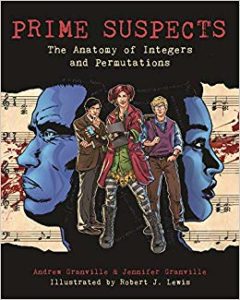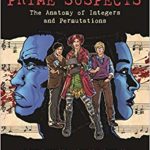PRIME SUSPECTS: THE ANATOMY OF INTEGERS AND PERMUTATIONS
Writers: Andrew Granville, Jennifer Granville
Illustrator: Robert J. Lewis
Publisher: Princeton University Press
Prime Suspects blends together the worlds of mathematics and forensic science to give readers both an interesting mystery and an education in numbers. When two dead bodies show up with seemingly no relation, except for their unique mutilation pattern, the police turn to the Mathematical Sciences Investigation team.
The team is led by Professor Gauss, who teaches graduate courses in forensic science by day and works on cases by night. Each semester he picks a research assistant to help him on a case. So who is the lucky student? Well, in this case there are two, and they couldn’t be more different. On one hand we have Emmy Germain: pink-haired, pierced, and decked out in quirky mathematical jewelry (chunky metal pie necklace, anyone?). She’s humble, weird, and knows how to explain advanced mathematical concepts to the lay person. On the other hand, we have Mr. Langer: glasses, sweater vests, and oh so pretentious. As I said, they couldn’t be more different, and while I typically loathe this kind of obvious character foil, it works to the story’s advantage here.
Due to their differences, as they approach the crime and its relationship to numbers, they break it down in multiple ways — ensuring that if you don’t understand the way Langer explains it, you have a chance to understand it from Emmy’s perspective. There’s also a television crew accompanying them on their investigation who consistently ask questions and need answers explained in the simplest way possible. I was extremely grateful for this, as my math knowledge is very basic to say the least. Accordingly, the relationship between Langer and Emily is a smart way to make Prime Suspects accessible to a variety of audiences.
To be fair, this is more a story of a numbers than of murder. The number talk definitely overshadows the mystery, but that’s okay, because that’s clearly the creators’ point. The way that Professor Gauss guides Lander and Emmy has the feeling of a textbook — but I don’t mean that in a bad way. As a teacher, I like using visual-heavy texts where there’s often a teacher character and one or two new student characters. It’s an effective approach, and one that I quite enjoy here.
The art is thick-lined with bold colors and glossy pages. It’s not a style I particularly enjoy, but the mainstream textbook-style art suits the story. The speech balloons are well-placed, and the letterer clearly knows how to use different fonts and speech balloon styles to convey a variety of tones and moods.
Overall, Prime Suspects is admirable for the way it makes advanced mathematics accessible. But this also makes it hard to determine who would enjoy this — beyond a math professor/enthusiast. Due to Princeton UP being the publisher, it’s more than likely intended for academic audiences. Accordingly, I think it’d be a fantastic addition to a college course on mathematics and/or forensic science. There’s also a bonus essay at the back written by the creators that dives more into the impetus behind the book and the mathematical principals driving it.
Prime Suspects: The Anatomy of Integers and Permutations will be available August 6, 2019.




